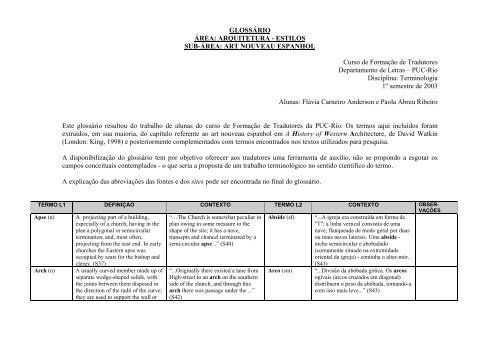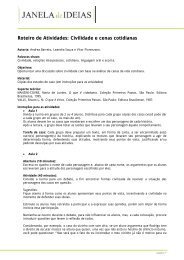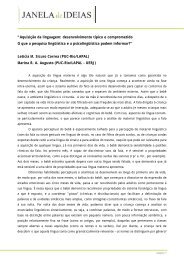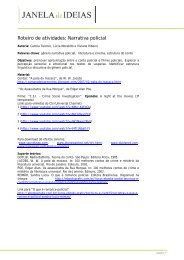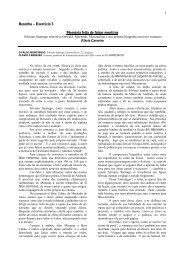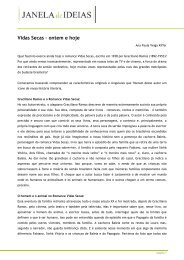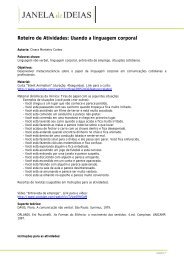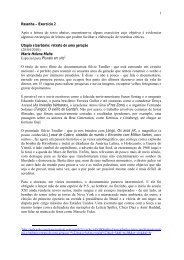ARQUITETURA - Departamento de Letras da PUC-Rio
ARQUITETURA - Departamento de Letras da PUC-Rio
ARQUITETURA - Departamento de Letras da PUC-Rio
Create successful ePaper yourself
Turn your PDF publications into a flip-book with our unique Google optimized e-Paper software.
GLOSSÁRIO<br />
ÁREA: <strong>ARQUITETURA</strong> - ESTILOS<br />
SUB-ÁREA: ART NOUVEAU ESPANHOL<br />
Curso <strong>de</strong> Formação <strong>de</strong> Tradutores<br />
<strong>Departamento</strong> <strong>de</strong> <strong>Letras</strong> – <strong>PUC</strong>-<strong>Rio</strong><br />
Disciplina: Terminologia<br />
1º semestre <strong>de</strong> 2003<br />
Alunas: Flávia Carneiro An<strong>de</strong>rson e Paola Abreu Ribeiro<br />
Este glossário resultou do trabalho <strong>de</strong> alunas do curso <strong>de</strong> Formação <strong>de</strong> Tradutores <strong>da</strong> <strong>PUC</strong>-<strong>Rio</strong>. Os termos aqui incluídos foram<br />
extraídos, em sua maioria, do capítulo referente ao art nouveau espanhol em A History of Western Architecture, <strong>de</strong> David Watkin<br />
(London: King, 1998) e posteriormente complementados com termos encontrados nos textos utilizados para pesquisa.<br />
A disponibilização do glossário tem por objetivo oferecer aos tradutores uma ferramenta <strong>de</strong> auxílio, não se propondo a esgotar os<br />
campos conceituais contemplados - o que seria a proposta <strong>de</strong> um trabalho terminológico no sentido científico do termo.<br />
A explicação <strong>da</strong>s abreviações <strong>da</strong>s fontes e dos sites po<strong>de</strong> ser encontra<strong>da</strong> no final do glossário.<br />
TERMO L1 DEFINIÇÃO CONTEXTO TERMO L2 CONTEXTO OBSER-<br />
VAÇÒES<br />
Apse (n) A projecting part of a building, “…The Church is somewhat peculiar in Absi<strong>de</strong> (sf) “...A igreja era construí<strong>da</strong> em forma <strong>de</strong><br />
especially of a church, having in the plan owing in some measure to the<br />
"T"; a linha vertical consistia <strong>de</strong> uma<br />
plan a polygonal or semicircular shape of the site; it has a nave,<br />
nave, flanquea<strong>da</strong> <strong>de</strong> modo geral por duas<br />
termination, and, most often, transepts and chancel terminated by a<br />
ou mais naves laterais. Uma absi<strong>de</strong> -<br />
projecting from the east end. In early semi-circular apse...” (S40)<br />
nicho semicircular e aboba<strong>da</strong>do<br />
churches the Eastern apse was<br />
(comumente situado na extremi<strong>da</strong><strong>de</strong><br />
occupied by seats for the bishop and<br />
oriental <strong>da</strong> igreja) - continha o altar-mór.<br />
clergy. (S37)<br />
(S41)<br />
Arch (n) A usually curved member ma<strong>de</strong> up of “...Originally there existed a lane from Arco (sm) “...Divisão <strong>da</strong> abóba<strong>da</strong> gótica. Os arcos<br />
separate wedge-shaped solids, with High-street to an arch on the southern<br />
ogivais (arcos cruzados em diagonal)<br />
the joints between them disposed in si<strong>de</strong> of the church, and through this<br />
distribuem o peso <strong>da</strong> abóba<strong>da</strong>, tornando-a<br />
the direction of the radii of the curve; arch there was passage un<strong>de</strong>r the ...”<br />
com isso mais leve...” (S43)<br />
they are used to support the wall or (S42)
Arch,<br />
parabolic<br />
(n+a)<br />
Arch, pointed<br />
(n+a)<br />
Art nouveau<br />
(n)<br />
other weight above an opening. In<br />
this sense arches are segmental,<br />
round (i.e. semicircular), or<br />
pointed.(S37)<br />
An arch that relates to, resembles, or<br />
has the form of a parabola<br />
(ADE)<br />
An arch that ends in a point or sharp<br />
angle.(AD)<br />
French for "The New Art." An art<br />
movement and style of <strong>de</strong>coration<br />
and architecture of the late nineteenth<br />
and early twentieth centuries,<br />
characterized particularly by the<br />
<strong>de</strong>piction of leaves and flowers in<br />
undulating lines, often flowing vines.<br />
(S1)<br />
Artifice (n) 1. Subtle but base <strong>de</strong>ception;<br />
trickery. A character of Mannerist<br />
art. (S44)<br />
Atrium (n) An inner courtyard of a home or<br />
other building that is open to the sky<br />
or covered by a skylight.<br />
(S39)<br />
Balcony (n) A platform projecting from the wall<br />
of a building, usually resting on<br />
“The use of parabolic, as opposed to<br />
pointed or semicircular arches, was<br />
also to be characteristic of Gaudí, who<br />
chose them for their static quality, not<br />
just because of their novel<br />
profile.”(HWA)<br />
“The use of parabolic, as opposed to<br />
pointed or semicircular arches, was<br />
also to be characteristic of Gaudí, who<br />
chose them for their static quality, not<br />
just because of their novel<br />
profile.”(HWA)<br />
“...The openings in the first and second<br />
floors have balconies ma<strong>de</strong> in forged<br />
iron, as it is common in Catalan Art<br />
Nouveau...” (S81)<br />
“... That the great monuments of the<br />
Greeks were imitations in stone of<br />
earlier woo<strong>de</strong>n temples makes the<br />
architecture that followed imitations of<br />
imitations. This artifice at the heart of<br />
classicism is it's strength...” (S45)<br />
“...The atrium's indoor gar<strong>de</strong>n, which<br />
is larger than one-third of an acre, is<br />
roofed by a "space-frame" of glass<br />
pyramids ...” (S47)<br />
“...The iri<strong>de</strong>scent mosaic tiles and<br />
undulating gallery gives the house a<br />
Arco parabólico<br />
(s+a)<br />
Arco ogival<br />
(s+a)<br />
Art nouveau<br />
(sm)<br />
“O arco parabólico é o que se parece<br />
com a parábola ou com a catenária.”<br />
(S19)<br />
“O arco ogival ou em ponta é típico do<br />
estilo gótico e permitia sustentar<br />
abóba<strong>da</strong>s eleva<strong>da</strong>s.” (S18)<br />
“...Na ver<strong>da</strong><strong>de</strong>, Gaudí se insere em um<br />
movimento artístico e arquitetônico<br />
conhecido como Art Nouveau, cujos<br />
<strong>de</strong>talhes exprimiam a preocupação com a<br />
beleza e a leveza sensual <strong>da</strong> natureza em<br />
formas estiliza<strong>da</strong>s, mo<strong>de</strong>la<strong>da</strong>s em ferro,<br />
vidro e ma<strong>de</strong>ira...”(S5)<br />
Artifício (sm) “...Em minha palestra eu mostro como a<br />
propagan<strong>da</strong> usa táticas <strong>de</strong> superposição<br />
para <strong>de</strong>sestabilizar o espaço entre o<br />
anúncio e o edifício como um artifício<br />
para chamar a atenção do observador...”<br />
( S46)<br />
Átrio (sm) “...A arquitetura singular, <strong>de</strong>fini<strong>da</strong> pelo<br />
prisma <strong>de</strong> vidro transparente que abriga o<br />
átrio, é o gran<strong>de</strong> <strong>de</strong>staque do edifício<br />
Briga<strong>de</strong>iro II...” (S48)<br />
Balcão (sm) “...No an<strong>da</strong>r superior, o balanço à<br />
esquer<strong>da</strong> é um balcão corrido contíguo ao<br />
Portugal: arte<br />
nova.<br />
Po<strong>de</strong> ser<br />
também<br />
utilizado com<br />
o artigo<br />
feminino (a art<br />
nouveau)
ackets or consoles, and enclosed by<br />
a parapet; for example as a balcony<br />
in front of a window. The term is<br />
also applied to a projecting gallery in<br />
places of amusement; for example<br />
the balcony in a theatre. (S37)<br />
Baroque (a) Of, relating to, or being a style of art<br />
and architecture prevalent from the<br />
latter part of the 16th century to the<br />
latter part of the 18th century,<br />
marked by dynamic opposition and<br />
energy, by the use of curved and<br />
plastic figures, and especially in its<br />
later phases by elaborate and<br />
sometimes grotesque ornamentation,<br />
and represented typically by the<br />
sculpture of Bernini and the painting<br />
of Rubens (WTN)<br />
Buttress (n) A projecting mass of masonry, used<br />
for resisting the outward thrust of an<br />
arch, or for ornament and symmetry.<br />
When an external projection is used<br />
merely to stiffen a wall, it is called a<br />
pier, rather than a buttress. (S37)<br />
Ceramic tile<br />
(n)<br />
Any of a wi<strong>de</strong> range of sturdy floor<br />
and wall tiles ma<strong>de</strong> from fired clay<br />
and set with grout. May be glazed or<br />
unglazed. Colors and finishes vary.<br />
May be used indoors or out.<br />
( S39)<br />
Chevet ( n) The extreme end of the chancel or<br />
choir in a church; the term being<br />
properly used to <strong>de</strong>scribe the round<br />
or polygonal part. (S37)<br />
cheerful expression until one's eyes rise<br />
to the heavy wrought-iron balcony,<br />
which rises up like masks...” (S49)<br />
Many writers draw no distinction<br />
between the words rococo and<br />
baroque, which are far from<br />
synonymous— (WTN)<br />
“...rather than uniformly thickened. For<br />
a load-bearing brick wall more than 8 ft<br />
(2 m) high a buttress is used every 20<br />
ft (6 m). The <strong>de</strong>corative possibilities of<br />
the buttress were discovered in the<br />
ancient temples at Abu Shahrein in<br />
Mesopotamia (3500–3000 B.C.), where<br />
they were used both as utilitarian and<br />
<strong>de</strong>corative forms...”<br />
(S52)<br />
Mo<strong>de</strong>rnist architects were much given<br />
to using ceramic tiles but the<br />
unprece<strong>de</strong>nted structural systems Gaudí<br />
<strong>de</strong>vised in or<strong>de</strong>r to be able to<br />
incorporate both natural and glazed<br />
tiles into his creations set him apart<br />
from the rest. (S54)<br />
“... The chevet of the church is semicircular.<br />
As a whole the building it<br />
homogeneous and has much to<br />
fascinate the visitor. ..” (S56)<br />
jantar, o frontal se divi<strong>de</strong>...” ( S50)<br />
Barroco (a) “.... Não fez parte <strong>de</strong> nenhuma escola. Foi<br />
buscar no simbolismo as referências <strong>da</strong><br />
natureza, a ornamentação no Barroco e o<br />
sensual na Art Noveau. Teve um <strong>de</strong>stino<br />
irônico, praticando o que acreditava...”<br />
(S51)<br />
Botaréu (sm) “...que compreen<strong>de</strong> um gracioso alpendre<br />
<strong>de</strong> quatro arca<strong>da</strong>s redon<strong>da</strong>s e<br />
contraforta<strong>da</strong>s, nascendo do chamado<br />
botaréu angular sul, <strong>de</strong> an<strong>da</strong>res, uma<br />
pequena esca<strong>da</strong> <strong>de</strong> acesso ao campanário<br />
...” (S53)<br />
Azulejo (sm) “... Gaudí trabalhava nela como quem faz<br />
um castelo <strong>de</strong> areia, salpicando <strong>de</strong>talhes e<br />
ignorando as linhas retas. Sempre usando<br />
material barato, como cacos <strong>de</strong> garrafas e<br />
pratos, azulejos e cerâmica...” (S55)<br />
Cabeceira (sf) “...O que <strong>de</strong> mais importante resta <strong>da</strong><br />
igreja é a cabeceira forma<strong>da</strong> por capelamor,<br />
cuja abóba<strong>da</strong> foi reconstruí<strong>da</strong>, e<br />
quatro capelas secundárias<br />
intercomunicantes...”
Chimneypot<br />
(n)<br />
A short earthenware or metal pipe<br />
that is placed on the top of a chimney<br />
in or<strong>de</strong>r to increase the draft.<br />
(MERL)<br />
Colonna<strong>de</strong> (n) A row of columns, frequently<br />
covered with a roof projecting from<br />
an adjacent building. Colonna<strong>de</strong>s<br />
were common in ancient Greece.<br />
When in front of a building, it is<br />
called a portico; when surrounding a<br />
building or an open court or square, it<br />
Courtyard (n)<br />
Craftmanship<br />
(n)<br />
is called a peristyle. (S 37)<br />
An area of ground that is surroun<strong>de</strong>d<br />
by buildings, lies insi<strong>de</strong> a large<br />
building, or is adjacent to a building<br />
and enclosed by walls. (MERL)<br />
The capacity to make or<br />
manufacture (an object, objects,<br />
product, etc.) with skill and careful<br />
attention to <strong>de</strong>tail.(AD)<br />
Cruciform (a) Shaped like a cross<br />
(MERL)<br />
Cupola (n) A roof or ceiling in the form of a<br />
dome (MERL)<br />
“The roofscape of the Palau Güell,<br />
forming an abstract sculptural<br />
composition with chimneypots and<br />
ventilators faced in coloured glass, tiles<br />
and mosaic, also set a prece<strong>de</strong>nt which<br />
Gaudí was often to follow.” (HWA)<br />
“...The exterior of the cupola is in three<br />
stages with a magnificent dome over a<br />
collona<strong>de</strong> of columns. The exterior<br />
portico is mo<strong>de</strong>lled on the Roman<br />
Pantheon and has ornate sculpture and<br />
22 columns...’ (S58)<br />
“Gaudí had a freer hand in the much<br />
larger and more unified Casa Milá<br />
(1906-10), which he built round two<br />
nearly circular courtyards in the same<br />
street as the Casa Batló, the fashionable<br />
Paseo <strong>de</strong> Gracia.”(HWA)<br />
“…Art Nouveau architects who, in<br />
addition, shared the belief of men like<br />
Ruskin and Cuypers in the necessity of<br />
reviving craftsmanship.” (HWA)<br />
“The Sagra<strong>da</strong> Familia was begun in<br />
1882 from <strong>de</strong>signs by Francesc <strong>de</strong><br />
Paula <strong>de</strong>l Villar I Carmona as a<br />
conventional cruciform Gothic<br />
church.”(HWA)<br />
“The spacial variety and complexity of<br />
the interior(…), culminates in the<br />
central domed hall, which rises to the<br />
top of the building and is lit by a<br />
cupola lined with hexagonal tiles and<br />
punctuated with numerous small<br />
apertures like stars.” (HWA)<br />
(S57)<br />
Chaminé (sf) “...Uma vez mais Gaudí recusa os ângulos<br />
e as esquinas e as chaminés assumem<br />
proporções ain<strong>da</strong> não experimenta<strong>da</strong>s<br />
antes...”(S13)<br />
Colunata (sf) "...estilos do passado. Assim, no Parque<br />
Güell há uma colunata dórica, na Casa<br />
Vicens, elementos hispano-árabes, etc...."<br />
(S59)<br />
Pátio (sm) “É a estrutura do que era o quartelgeneral<br />
dos Cavaleiros <strong>de</strong> S. João, um<br />
gran<strong>de</strong> conjunto <strong>de</strong> edifícios (cerca <strong>de</strong><br />
4.500 m2) com muralhas e inúmeras salas<br />
construí<strong>da</strong>s em torno <strong>de</strong> um amplo pátio<br />
Habili<strong>da</strong><strong>de</strong><br />
artesanal (s+a)<br />
Cruciforme<br />
(sm)<br />
central aberto.” (S23)<br />
“Já houve o tempo em que se julgava arte<br />
pela habili<strong>da</strong><strong>de</strong> artesanal e pela<br />
interferência <strong>da</strong>s mãos do autor.” (S7)<br />
“Orientado a sul, o templo tem planta<br />
cruciforme, com o transepto semelhante<br />
às naves.” (S25)<br />
Cúpula (sf) “...As características predominantes<br />
seriam a cúpula (parte superior e côncava<br />
dos edifícios) e a planta <strong>de</strong> eixo central,<br />
também chama<strong>da</strong> <strong>de</strong> planta <strong>de</strong> cruz grega<br />
(quatro braços iguais). A cúpula<br />
procurava reproduzir a abóba<strong>da</strong> celeste...”<br />
(S15)<br />
Mais<br />
especifica-<br />
mente, “cano<br />
<strong>de</strong> chaminé”<br />
Variação:<br />
coluna<strong>da</strong>
Domed hall<br />
(a+n)<br />
Doric column<br />
(a+n)<br />
Entablature<br />
(n)<br />
A large room or lobby that has a<br />
dome. (ADE)<br />
A Greek-style column that has a<br />
simple <strong>de</strong>coration around the top,<br />
usually a smooth or slightly roun<strong>de</strong>d<br />
band of wood, stone or plaster. (S4)<br />
In classical architecture, the section<br />
that lies between the columns and the<br />
roof. It comprises, from bottom to<br />
top, the architrave, frieze, and<br />
cornice. (MERL)<br />
Faça<strong>de</strong> (n) The face of a building, especially the<br />
principal or front face showing its<br />
most prominent architectural features<br />
(MERL)<br />
Finial (n) A carved <strong>de</strong>coration at the top of a<br />
gable, spire, or arched structure.<br />
(MERL)<br />
Flying<br />
buttress (n)<br />
It is a contrivance for taking up the<br />
thrust of a roof or vault which can<br />
not be supported by ordinary<br />
buttresses. It consists of a straight bar<br />
“The spacial variety and complexity of<br />
the interior(…), culminates in the<br />
central domed hall, which rises to the<br />
top of the building and is lit by a cupola<br />
lined with hexagonal tiles and<br />
punctuated with numerous small<br />
apertures like stars.” (HWA)<br />
“The principal building is the Greek<br />
Theatre, with tilted Greek Doric<br />
columns surmounted by an undulating<br />
entablature which, <strong>de</strong>corated with<br />
moul<strong>de</strong>d ceramics, also serves as a<br />
bench terminating the roof<br />
terrace.”(HWA)<br />
“The principal building is the Greek<br />
Theatre, with tilted Greek Doric<br />
columns surmounted by an undulating<br />
entablature which, <strong>de</strong>corated with<br />
moul<strong>de</strong>d ceramics, also serves as a<br />
bench terminating the roof<br />
terrace.”(HWA)<br />
“The stone faça<strong>de</strong> of the Casa Milá is<br />
enlivened with balconies of wrought<br />
iron tortured so as to resemble<br />
glistening bunches of seething<br />
seaweed, perhaps the most vivacious<br />
Art Nouveau metalwork anywhere”.<br />
(HWA)<br />
“In 1903-30 the Nativity transept, with<br />
its gables resembling stalactites, was<br />
completed with the addition of towers<br />
and openwork cone-shaped spires of<br />
astonishing height, crowned with<br />
tentacle-like finials of coloured broken<br />
tiling.” (HWA)<br />
“...The columns are not vertical but<br />
near the top (shown) have an inward<br />
branching making a parabola that<br />
Saguão<br />
aboba<strong>da</strong>do<br />
(s+a)<br />
Coluna dórica<br />
(s+a)<br />
Entablamento<br />
(sm)<br />
Facha<strong>da</strong><br />
(sf)<br />
“As mais belas residências <strong>de</strong> estilo árabe<br />
encontram-se em to<strong>da</strong>s as capitais do<br />
Mundo Árabe, entra-se sempre nessas<br />
casas por um saguão aboba<strong>da</strong>do e<br />
estreito on<strong>de</strong> estão os criados, e em cujo<br />
extremo se <strong>de</strong>semboca num gran<strong>de</strong><br />
pátio.” (S14)<br />
“Ao contrário <strong>da</strong> coluna dórica, a jônica<br />
não assenta diretamente sobre patamares,<br />
mas tem uma base - plinto - que assume<br />
diversas formas.” (S16)<br />
“A escolha do estilo levou a uma<br />
composição dos alçados exteriores,<br />
simétricos dois a dois, on<strong>de</strong> se empregou<br />
a or<strong>de</strong>m dórica, sem caneluras no fuste,<br />
em pilastras monumentais que vencem os<br />
dois an<strong>da</strong>res do edifício até o<br />
entablamento que o circun<strong>da</strong>.” (S17)<br />
“Compreen<strong>de</strong> a facha<strong>da</strong> do edifício to<strong>da</strong>s<br />
as suas partes externas<br />
visíveis e também as não visíveis (frente,<br />
fundos e laterais).” (S22)<br />
Remate (sm) “No interior, a nave, do lado <strong>da</strong> Epístola,<br />
tem um púlpito com balaustra<strong>da</strong><br />
<strong>de</strong> ma<strong>de</strong>ira, suportado por uma mísula em<br />
granito com remate em volutas.” (S31)<br />
Arcobotante<br />
(sm)<br />
“...a planta constitui uma reinterpretação<br />
dos mo<strong>de</strong>los góticos, havendo colunas<br />
inclina<strong>da</strong>s que assumem o papel <strong>de</strong><br />
arcobotantes; e, sobretudo, prevalece<br />
Variação L1,<br />
arcboutant ;<br />
L2 arco
of masonry, usually sloping, carried<br />
on an arch, and a solid pier or<br />
buttress sufficient to receive the<br />
thrust. The word is generally applied<br />
only to the straight bar with<br />
supporting arch. (S37)<br />
Gable (n) The portion of the front or si<strong>de</strong> of a<br />
building enclosed by or masking<br />
the end of a pitched roof. (RHW)<br />
Gothic (n) General term for a style of<br />
architecture and ornament prevalent<br />
between the twelfth and sixteenth<br />
centuries, consi<strong>de</strong>red old-fashioned<br />
in the seventeenth and early<br />
eighteenth centuries, characterised by<br />
pointed arches, ribbed vaulting, and<br />
flying buttresses, and by grotesque<br />
<strong>de</strong>corations; when it came back into<br />
fashion in the mid-1700s, it was<br />
celebrated as a symbol of British<br />
patriotism. (S3)<br />
Grille (n) 1 a : a grating (as of wrought iron,<br />
bronze, or wood) forming an often<br />
elaborate openwork barrier, screen,<br />
or cover (as to a door, window, or<br />
other opening) (WTN)<br />
Grotesque<br />
(adj, n)<br />
In art, a kind of ornament used<br />
in antiquity consisting of<br />
representations of me<strong>da</strong>llions,<br />
sphinxes, foliage, and imaginary<br />
creatures.(S68)<br />
eliminates the need for flying<br />
buttresses...” (S61)<br />
“...Its symmetry, balance and or<strong>de</strong>rly<br />
rhythm are unusual for Gaudí's works.<br />
However, the curves and double gable<br />
at the top, the projecting oriel at the<br />
entrance--almost baroque in its drama,<br />
and isolated witty <strong>de</strong>tails are<br />
mo<strong>de</strong>rnista elements. (S63)<br />
“Antoni Gaudí began as a Gothic<br />
Revivalist but in his characteristically<br />
exuberant Casa Vicens (…) the railings<br />
and gates have an early Art Nouveau<br />
flavour.”(HWA)<br />
“...The work stretched out for thirteen<br />
years due to lack of funds, until finally<br />
Jeroni Martorell was able to make the<br />
magnificent wrought-iron grille that<br />
closes the grotto...”<br />
(S66)<br />
“...During the Gothic Revival in Britain<br />
and France, the grotesque represented<br />
a world turned upsi<strong>de</strong> down, where, for<br />
instance, monsters guar<strong>de</strong>d the<br />
church....” (S69)<br />
uma relação orgânica entre o interior e o<br />
exterior, consegui<strong>da</strong> mercê <strong>de</strong><br />
originalíssimas soluções <strong>de</strong> problemas<br />
estruturais...” (S62)<br />
Frontão (sm) “...Em meio <strong>de</strong> quadra, a Casa Calvet<br />
(1898-99), <strong>de</strong> planta simples e quase<br />
simétrica, é anima<strong>da</strong> sutilmente, <strong>de</strong> frente<br />
para a rua, pela rusticação <strong>da</strong> facha<strong>da</strong><br />
pétrea com as saca<strong>da</strong>s e frontões curvos,<br />
enquanto a facha<strong>da</strong> s...” (S64)<br />
Gótico (a) “A arquitetura gótica se apoiava nos<br />
princípios <strong>de</strong> um forte simbolismo<br />
teológico, fruto do mais puro pensamento<br />
escolástico: as pare<strong>de</strong>s eram a base<br />
espiritual <strong>da</strong> Igreja, os pilares<br />
representavam os santos, e os arcos e os<br />
nervos eram o caminho para Deus.” (S8)<br />
Gra<strong>de</strong> (sf) “... No Brasil, o art nouveau chegou<br />
através <strong>da</strong> influência francesa,<br />
especialmente na <strong>de</strong>coração <strong>de</strong> interiores,<br />
gra<strong>de</strong>s e objetos <strong>de</strong> ferro forjado. A<br />
confeitaria Colombo, no centro <strong>da</strong> ci<strong>da</strong><strong>de</strong><br />
do <strong>Rio</strong> <strong>de</strong> Janeiro, é um exemplo <strong>de</strong>ste<br />
Grotesco<br />
(s, adj)<br />
estilo...” (S67)<br />
“...Mais tar<strong>de</strong> acentuam-se a sua mal<strong>da</strong><strong>de</strong><br />
e o seu caráter disforme e assustador, que<br />
irá aos poucos se tornando menos<br />
<strong>de</strong>moníaco e mais caricato, característica<br />
que evi<strong>de</strong>ncia o termo grotesco, <strong>da</strong>do o<br />
exagero nas poses e expressões dos<br />
personagens...”<br />
(S70)<br />
botante
Layout (n) A <strong>de</strong>sign or plan that shows the way<br />
things are arranged . (ADE)<br />
Mosaic (n) The use of small pieces of glass,<br />
stone, or tile (tesserae), or pebbles, to<br />
create and image on a flat surface<br />
such as floor, wall, or ceiling<br />
(S71)<br />
Mullion (n)<br />
A vertical piece of stone, metal, or<br />
wood that divi<strong>de</strong>s the panes of a<br />
window or the panels of a screen.<br />
(MERL)<br />
Nave (n) The long central hall of a crossshaped<br />
church, often with pillars on<br />
each si<strong>de</strong>, where the congregation<br />
sits (MERL)<br />
Openwork (n) Decorative items that make use of<br />
patterns of holes, for example<br />
wrought-iron work, fretwork, or lace<br />
(MERL)<br />
Organic<br />
Architecture<br />
(a+n)<br />
It is a term Frank Lloyd Wright used<br />
to <strong>de</strong>scribe his approach to<br />
architectural <strong>de</strong>sign. The philosophy<br />
grew from the i<strong>de</strong>as of Wright's<br />
mentor, Louis Sullivan, who believed<br />
that “form follows function.” Wright<br />
argued that “form and function are<br />
one.” (S82)<br />
“Domènech’s masterpieces, grandiose<br />
in scale and exotic in <strong>de</strong>tail, are the<br />
Hospital of S.Pau, Barcelona (1902-<br />
10), and the Palau <strong>de</strong> la Música<br />
Catalana (1905-8), the former with an<br />
exten<strong>de</strong>d layout like an English gar<strong>de</strong>n<br />
city.”(HWA)<br />
“... Sagra<strong>da</strong> Familia (1883), is a church<br />
reminiscent of the Gothic tradition, but<br />
the ornate use of sculpture and mosaic<br />
tiling is unmistakably Gaudi....”<br />
(S72)<br />
“…their interiors were iron cages with<br />
conventional partitions largely replaced<br />
by slen<strong>de</strong>r iron mullions so as to<br />
obstruct the sales areas as little as<br />
possible.”<br />
(HWA)<br />
“Work still continues slowly on the<br />
nave, structurally the most original part<br />
of the whole church(…)” (HWA)<br />
“In 1903-30 the Nativity transept, with<br />
its gables resembling stalactites, was<br />
completed with the addition of towers<br />
and openwork cone-shaped spires of<br />
astonishing height, crowned with<br />
tentacle-like finials of coloured broken<br />
tiling.”(HWA)<br />
“So here I stand before you preaching<br />
organic architecture: <strong>de</strong>claring organic<br />
architecture to be the mo<strong>de</strong>rn i<strong>de</strong>al<br />
and the teaching so much nee<strong>de</strong>d if we<br />
are to see the whole of life, and to now<br />
serve the whole of life, holding no<br />
‘traditions’ essential to the great<br />
TRADITION.<br />
Projeto (sm) “Manuel Francisco Lisboa é o autor do<br />
projeto <strong>da</strong> Igreja <strong>de</strong> Nossa Senhora do<br />
Carmo,<br />
<strong>de</strong>pois alterado por seu filho, Antônio<br />
Francisco Lisboa, o Aleijadinho.” (S36)<br />
Mosaico (sm) “...a restauração dos elementos originais<br />
catalogados como os mais importantes e<br />
em bom estado <strong>de</strong> conservação, entre eles<br />
as colunas com capitéis <strong>de</strong> gesso, as<br />
luminárias, o piso <strong>de</strong> mosaico veneziano<br />
e as portas em latão... “(S73)<br />
Mainel (sm) “No registo inferior, ao centro do mainél<br />
que divi<strong>de</strong> a porta, uma estátua do Infante<br />
D. Henrique. O portal é la<strong>de</strong>ado por dois<br />
janelões <strong>de</strong> arco redondo. ...” (S9)<br />
Nave (sf) “Um dos motivos para a elaboração do<br />
projeto foi a atual via-sacra <strong>da</strong> catedral<br />
que fica no fundo <strong>da</strong> nave <strong>da</strong> igreja.”<br />
(S32)<br />
Vazado (a) “O átrio será ain<strong>da</strong> mais utilizado quando<br />
trepa<strong>de</strong>iras tomarem conta <strong>de</strong> parte <strong>da</strong><br />
"arapuca" metálica que lhe serve <strong>de</strong> teto<br />
vazado.” (S29)<br />
Arquitetura<br />
Orgânica<br />
(s+a)<br />
“Biografia, lista <strong>de</strong> projetos construídos,<br />
<strong>de</strong>poimentos, informações sobre Taliesin<br />
West, arquivos, links, etc - tudo<br />
relacionado com o gran<strong>de</strong> mestre <strong>da</strong><br />
arquitetura orgânica encontra-se no site<br />
oficial <strong>da</strong> Fun<strong>da</strong>ção Frank Lloyd Wright.”<br />
(S28)<br />
Também po<strong>de</strong>se<br />
utilizar<br />
“coluneta”
Organic<br />
<strong>de</strong>sign (a+n)<br />
Piano nobile<br />
(n+a)<br />
A <strong>de</strong>sign style characterized by fluid<br />
transitions, smoothed edges, things<br />
blending in with each other, and<br />
roun<strong>de</strong>d forms. Many 20th century<br />
artists favored a style called<br />
"biomorphic abstraction," where<br />
continuous curvilinear shapes<br />
suggest living organisms. (S2)<br />
The main floor of a building where<br />
the most important rooms would be<br />
located: literally "noble storey" in<br />
Italian. (S38)<br />
Pier (n) A pillar, especially a rectangular one<br />
supporting the end of an arch, lintel,<br />
or vault. (MERL)<br />
Prop (n) A rigid object such as a beam, stake,<br />
or pole that supports something or<br />
holds it in place. (MERL)<br />
Railing (n) A fencelike barrier composed of<br />
one or more horizontal rails<br />
supported by wi<strong>de</strong>ly spaced<br />
uprights; balustra<strong>de</strong>. (RHW)<br />
Roofscape (n) The external upper covering of a<br />
house or other building that may<br />
have a terrace, offer a view or have a<br />
visual character. (ADW)<br />
Spire (n) The name given to the roof of a<br />
tower when of a pyrami<strong>da</strong>l form and<br />
(FLK)<br />
“The calls for structural honesty by<br />
Viollet-le-Duc and for organic <strong>de</strong>sign<br />
by Sullivan were also given expression<br />
by art nouveau architects…”<br />
(HWA)<br />
“...The reconstructed Piano Nobile,<br />
believed to have been the official royal<br />
resi<strong>de</strong>nce and reception rooms, is on<br />
the west si<strong>de</strong> of the court. This upper<br />
floor provi<strong>de</strong>s an excellent view of the<br />
palace storerooms...”<br />
(S74)<br />
“He treated the piers as tree-trunks,<br />
tilting them inwards so as to counteract<br />
the thrust of the vault without recourse<br />
to any props or flying buttresses, which<br />
he dismissed as ‘crutches’.”(HWA)<br />
“He treated the piers as tree-trunks,<br />
tilting them inwards so as to counteract<br />
the thrust of the vault without recourse<br />
to any props or flying buttresses,<br />
which he dismissed as ‘crutches’.”<br />
(HWA)<br />
“…But in his characteristically<br />
exuberant Casa Vicens (…), the<br />
railings and gates have an early Art<br />
Nouveau flavour.”(HWA)<br />
“The roofscape of the Palau Güell,<br />
forming an abstract sculptural<br />
composition with chimneypots and<br />
ventilators faced in coloured glass, tiles<br />
and mosaic, also set a prece<strong>de</strong>nt which<br />
Gaudí was often to follow.” (HWA)<br />
“...The spires and ceiling support are of<br />
catenary arches - the asymmetric form<br />
Desenho<br />
orgânico (s+a)<br />
Piano nobile<br />
(s+a)<br />
Pilastra (sf)<br />
Estaca (sf)<br />
“Platiban<strong>da</strong> em concreto com vazados<br />
geométricos simulando os <strong>de</strong>senhos dos<br />
gradis <strong>de</strong> ferro tão em uso na época.<br />
Detalhe <strong>da</strong> porta principal com <strong>de</strong>senho<br />
orgânico, lembra a asa <strong>de</strong> um inseto,<br />
muito utilizado pelas propostas art <strong>de</strong>cor<br />
e art nouveau.” (S6)<br />
“...O seu uso significa, como em<br />
Corbusier, a "reinterpretação" do<br />
princípio clássico do podium, substituí<strong>da</strong><br />
a massa edifica<strong>da</strong> que se ocupava <strong>de</strong><br />
separar o piano nobile do solo pelo vazio<br />
entre colunas...” (S75)<br />
“Outro problema freqüente que ocorre<br />
após a conclusão <strong>da</strong> obra é a insatisfação<br />
do(a) proprietário(a) com a posição <strong>de</strong><br />
alguma pilastra.” (S33)<br />
“A estaca fixa tem a finali<strong>da</strong><strong>de</strong> <strong>de</strong> manter<br />
as linhas <strong>de</strong> uma cerca sempre a uma<br />
mesma distância, permitindo aumentar a<br />
distância entre os moirões.” (S34)<br />
Balaustra<strong>da</strong> (sf) “O terraço era cercado por uma<br />
balaustra<strong>da</strong> <strong>de</strong> bronze e contava com<br />
uma iluminação especial, forneci<strong>da</strong> por<br />
lampiões <strong>de</strong> óleo <strong>de</strong> peixe...” (S10)<br />
Teto-terraço<br />
(sm)<br />
“As <strong>de</strong>zoito chaminés levanta<strong>da</strong>s no tetoterraço<br />
se vestem com cacos <strong>de</strong> vidro,<br />
pedra e azulejos à maneira <strong>de</strong> pinhas ou<br />
ciprestes ro<strong>de</strong>ando a espira sobre a<br />
cúpula.” (S12)<br />
Flecha (sf) “E as altíssimas naves <strong>da</strong>s catedrais<br />
góticas coroa<strong>da</strong>s por magníficas torres e<br />
Portugal:an<strong>da</strong>r<br />
nobre<br />
Ou pilar<br />
Também po<strong>de</strong>se<br />
utilizar<br />
“colunas ou<br />
apoios”<br />
Também<br />
chama<strong>da</strong> <strong>de</strong>
high in proportion to its width. The<br />
name is also given to the pyrami<strong>da</strong>l<br />
or aspiring termination of a tower<br />
which can not be said to have a roof,<br />
such as that of Strasburg cathedral;<br />
and to the tapering part of a steeple,<br />
or the steeple itself. (S37)<br />
Transept (n) The cross aisles of a church,<br />
projecting at right angles from the<br />
nave or choir. In the basilicas, they<br />
often had no projection at the two<br />
ends. In Gothic churches these<br />
project greatly, and should be called<br />
the arms of the transept. It is<br />
common, however, to speak of the<br />
arms themselves as the transepts.<br />
(S37)<br />
Turret (n) A small roun<strong>de</strong>d tower that projects<br />
from a wall or corner of a large<br />
building such as a castle (MERL)<br />
Vault (n) An arched structure of stone, brick,<br />
wood, or plaster that forms a ceiling<br />
or roof. (MERL)<br />
Wrought iron<br />
(a+n)<br />
A highly refined form of iron that is<br />
easy to shape but is strong and fairly<br />
resistant to rust, wi<strong>de</strong>ly used for<br />
<strong>de</strong>corative metalwork. Wrought iron<br />
contains only 1 to 3 per cent of<br />
silicate slag distributed in fibers<br />
within the iron, thus making it very<br />
malleable. (MERL)<br />
of a parabola that he <strong>de</strong>veloped doing<br />
Casa Mila. ...” (S76)<br />
“...The south transept at Hunston is as<br />
big as the nave, creating a most unusual<br />
effect in this tiny village church…”<br />
(S77)<br />
“At one si<strong>de</strong> rises a turret capped with<br />
a cross and the initials in gold of the<br />
Holy Family.” (HWA)<br />
“He treated the piers as tree-trunks,<br />
tilting them inwards so as to counteract<br />
the thrust of the vault without recourse<br />
to any props or flying buttresses, which<br />
he dismissed as ‘crutches’.” (HWA)<br />
“The stone faça<strong>de</strong> of the Casa Milá is<br />
enlivened with balconies of wrought<br />
iron tortured so as to resemble<br />
glistening bunches of seething<br />
seaweed, perhaps the most vivacious<br />
Art Nouveau metalwork anywhere”.<br />
(HWA)<br />
Abreviaturas utiliza<strong>da</strong>s no fichamento e referências bibliográficas<br />
esbeltas flechas, que com freqüência<br />
vieram abaixo, foram ergui<strong>da</strong>s para que,<br />
nas palavras <strong>de</strong> Christian Norberg-Schulz,<br />
“Deus se acercará do homem”. (S83)<br />
Transepto (sm) “O transepto é constituído por dois<br />
braços, o direito e o esquerdo. No Braço<br />
esquerdo do transepto encontra-se a<br />
imagem <strong>de</strong> Nossa Senhora <strong>da</strong><br />
Vandoma...” (S78)<br />
Torreão (sm) “No topo <strong>de</strong>sta torre, ou Torreão Central,<br />
encontrava-se uma plataforma<br />
<strong>de</strong>vi<strong>da</strong>mente prepara<strong>da</strong> para a colocação<br />
<strong>de</strong> peças <strong>de</strong> fogo, aumentando o po<strong>de</strong>r<br />
<strong>de</strong>fensivo <strong>da</strong> Fortaleza <strong>de</strong> Sagres.” (S21)<br />
Abóba<strong>da</strong> (sf) “As colunas góticas eram forma<strong>da</strong>s <strong>de</strong><br />
feixes <strong>de</strong> pilares, eram grossas, fortes<br />
e gran<strong>de</strong>s e tinham a função <strong>de</strong> sustentar<br />
to<strong>da</strong> a estrutura <strong>da</strong> abóba<strong>da</strong>.” (S20)<br />
Ferro forjado<br />
(s+a)<br />
“Utilizando o ferro forjado como<br />
matéria prima, produziam-se ferraduras,<br />
camas, bancos <strong>de</strong> jardim e gra<strong>de</strong>amento<br />
para varan<strong>da</strong>s ou janelas.” (S24)<br />
coruchéu ou<br />
agulha
Informações gramaticais:<br />
L1: n. = noun<br />
a. = adjective<br />
v. = verb<br />
L2: s. = substantivo<br />
m. = masculino<br />
f.= feminino<br />
a. = adjetivo<br />
v. = verbo<br />
Referências bibliográficas:<br />
Teórica:<br />
ALVES, Ie<strong>da</strong> M. (1996) “Definição terminológica: <strong>da</strong> teoria ã prática”. TradTerm 3, p. 125-136.<br />
Fontes dos termos:<br />
AH - Houaiss, Antonio<br />
CAL - Cambridge Advanced Learner’s Dictionary<br />
HWA – Watkin, David (1998) A History of Western Architecture. London: King.<br />
MERL - Microsoft® Encarta® Reference Library 2003.<br />
AD - A<strong>da</strong>ptação<br />
ADE – A<strong>da</strong>ptação do Microsoft® Encarta® Reference Library 2003<br />
ADW – A<strong>da</strong>ptação do Random House Webster’s Unabridged Dictionary e do site<br />
www.cityofseattle.net/npo/plans/elake/appendices.pdf<br />
RHW - Random House Webster’s Unabridged Dictionary<br />
WTN- Webster Third New Dictionary<br />
FLK - Wright, Frank Lloyd. An Organic Architecture, 1939<br />
Sites:<br />
S 1. http://www.artlex.com/ArtLex/a/artnouveau.html<br />
S 2. www.phxart.org/vitra.html<br />
S 3. www.geocities.com/rho<strong>de</strong>c_asid_stu<strong>de</strong>nt_chapter/ Designcenter.html - 19k
S 4. www.masshomes.com/michaeldurkin/glossary.html - 32k<br />
S 5. www.aomestrecomcarinho.com.br/tur/gaudi.htm<br />
S 6. www.casaecia.arq.br/art_<strong>de</strong>cor1.htm<br />
S 7. www.geocities.com/SoHo/6490/masp.htm<br />
S 8. pegue.com/artes/arquitetura_gotica.htm<br />
S 9. www.ippar.pt/monumentos/conjunto_jeronimos.html - 36k<br />
S 10. www.passeiopublico.com.br/construcao.htm - 21k -<br />
S 11. www.bbc.co.uk/portuguese/noticias/ 021201_bangla<strong>de</strong>shae.shtml<br />
S 12. www.arcoweb.com.br/<strong>de</strong>bate/<strong>de</strong>bate33.asp - 48k<br />
S 13. www.ufp.pt/~slira/Licenciatura/gaudi.htm<br />
S 14. www.islam.com.br/arabes.htm - 7k<br />
S 15. pegue.com/artes/arquitetura_bizantina.htm<br />
S 16. pegue.com/artes/jonica.htm - 8k<br />
S 17. www.alepe.pe.gov.br/perfil/assembleia/construcao.html - 6k -<br />
S 18. www.pegue.com/artes/berco.htm - 10k<br />
S 19. www.mat.uel.br/geometrica/8tarq.htm - 8k -<br />
S 20. www.classicismo.hpg.ig.com.br/ciencia_e_educacao/ 8/in<strong>de</strong>x_int_6.html - 8k<br />
S 21. www.ippar.pt/sites_externos/ sagres/Siteport/fsagres.htm - 16k<br />
S 22. www.netcond.com.br/termos/facha<strong>da</strong>.htm - 5k -<br />
S 23. www.mfa.gov.il/mfa/go.asp?MFAH0gva0 - 31k<br />
S 24. www.eq.uc.pt/~jorge/ague<strong>da</strong>/ag-artesanato.html -<br />
S 25. www.bragancanet.pt/patrimonio/miran<strong>da</strong>igreja.htm - 7k<br />
S 26. www.terravista.pt/ancora/2515/sabadim.html - 11k<br />
S 27. geocities.yahoo.com.br/cmpoerto/francisc.htm - 8k -<br />
S 28. www.sobresites.com/arquitetura/arquitetos.htm<br />
S 29. www.unb.br/fau/pos_graduacao/ca<strong>de</strong>rnos_eletronicos/ uma_casa_atrio_mo<strong>de</strong>rna/casatrio.htm- 14k<br />
S 30. www.cosmo.com.br/viagem/materias/ numagela<strong>da</strong>/001022_numa_03.shtm - 32k<br />
S 31. www.bragancanet.pt/patrimonio/vimiosooutro.htm - 17k<br />
S 32. www.noolhar.com/opovo/fortaleza/242445.html - 34k -<br />
S 33. www.curitibaconstrucao.com.br/plan.htm - 11k -<br />
S 34. orbita.starmedia.com/~starmanjua/aplicacao.htm - 10k -<br />
S 35. geocities.yahoo.com.br/vinicrashbr/ artes/arquitetura/arquitetura.htm - 19k<br />
S 36. www.ci<strong>da</strong><strong>de</strong>shistoricas.art.br/hac/bio_manu_p.htm - 34k -<br />
S 37-www.probertencyclopaedia.com/T2.HTM
S 38- panther.bsc.edu/~jtatter/glossary.html<br />
S 39- www.masshomes.com/michaeldurkin/glossary.html<br />
S 40- www.ely.anglican.org/parishes/camstmatts/ old/Architecture.html<br />
S 41- www.israel-mfa.gov.il/mfa/go.asp?MFAH0gul0<br />
S 42- indigo.ie/~kfinlay/Gilbert/gilbert8.htm<br />
S 43- pegue.com/artes/arquitetura_gotica.htm<br />
S 44- www.ug.it.usyd.edu.au/~dsweetin/glossary.htm<br />
S 45- www.classicist.org/bboard/old_messages/173.html<br />
S 46- www.puccamp.br/~fau/LA/artigos/perrella/baltazar.htm<br />
S 47-www.nga.gov/collection/eastarch3.htm<br />
S 48- arcoweb.com.br/arquitetura/arquitetura380.asp<br />
S 49- www.cbrava.com/gaudi.uk.htm<br />
S 50- www.vitruvius.com.br/arquitextos/ arq022/bases/01tex.asp<br />
S 51- www.bon<strong>de</strong>.com.br/topmagazine/top_40/barcelona5.htm<br />
S 52- www.1upinfo.com/encyclopedia/B/buttress.html<br />
S-53- www.cm-beja.pt/freguesias/trin<strong>da</strong><strong>de</strong>.htm<br />
S 54- spaintiles.info/eng/historia/gaudi.asp<br />
S 55-www.lasagra<strong>da</strong>familia.com.br/gaudi.htm<br />
S 56- www.internetcom.fr/corsica/uk/ regajac/cargese/carg_egl.htm<br />
S 57- www.utl.pt/GuiaECTS/V-C-Monumentos.htm<br />
S 58- www.archiseek.com/gui<strong>de</strong>s/france/paris/pantheon.html<br />
S 59- www.vi<strong>da</strong>slusofonas.pt/antonio_gaudi.htm<br />
S 60- www.etnias.hpg.ig.com.br/catedral.htm<br />
S 61- www.pagehalffull.com/barcelona2.html<br />
S 62- www.vi<strong>da</strong>slusofonas.pt/antonio_gaudi.htm<br />
S 63- www.bluffton.edu/~sullivanm/spain/barcelona/ gaudicalvet/gaudicalvet.html<br />
S 64- www.arcoweb.com.br/<strong>de</strong>bate/<strong>de</strong>bate33.asp<br />
S 65- www.loggia.com/<strong>de</strong>signarts/architecture/bio/gaudi.html<br />
S 66- www.rutamo<strong>de</strong>rnisme.com/gaudi/e/ruta_fora02.html<br />
S 67- artesanatoecia.riobrasil.com.br/arte.html<br />
S 68- tudorhistory.org/glossaries/archglos.html<br />
S 69- cidc.library.cornell.edu/adw/gravely/revival.html<br />
S 70- igspot.ig.com.br/sistinas/quimeras.html<br />
S 71- www.ug.it.usyd.edu.au/~dsweetin/glossary.htm
S 72- shop.store.yahoo.com/airline/acmospenbyga.html<br />
S 73-www.arcoweb.com.br/arquitetura/arquitetura118.asp<br />
S 74- www.crete.tournet.gr/MainArea.jdp?ID=380<br />
S 75- www.unimar.br/publicacoes/assentamentos/ assent_humano3v2/renato.htm<br />
S 76- www.pagehalffull.com/barcelona2.html<br />
S 77- www.suffolkchurches.co.uk/ztransept.htm<br />
S 78- atelier.hannover2000.mct.pt/~pr367/Transepto.htm<br />
S 79- glasssteelandstone.com/IL/JerusalemDomeoftheRock.html<br />
S 80- www.vitruvius.com.br/arquitextos/ arq017/bases/01tex.asp<br />
S 81- www.gaudiallgaudi.com/AMWSit.htm<br />
S 82- architecture.about.com/library/bl- glossary.htm<br />
S 83- www.vitruvius.com.br/arquitextos/ arq017/bases/01tex.asp - 13k


